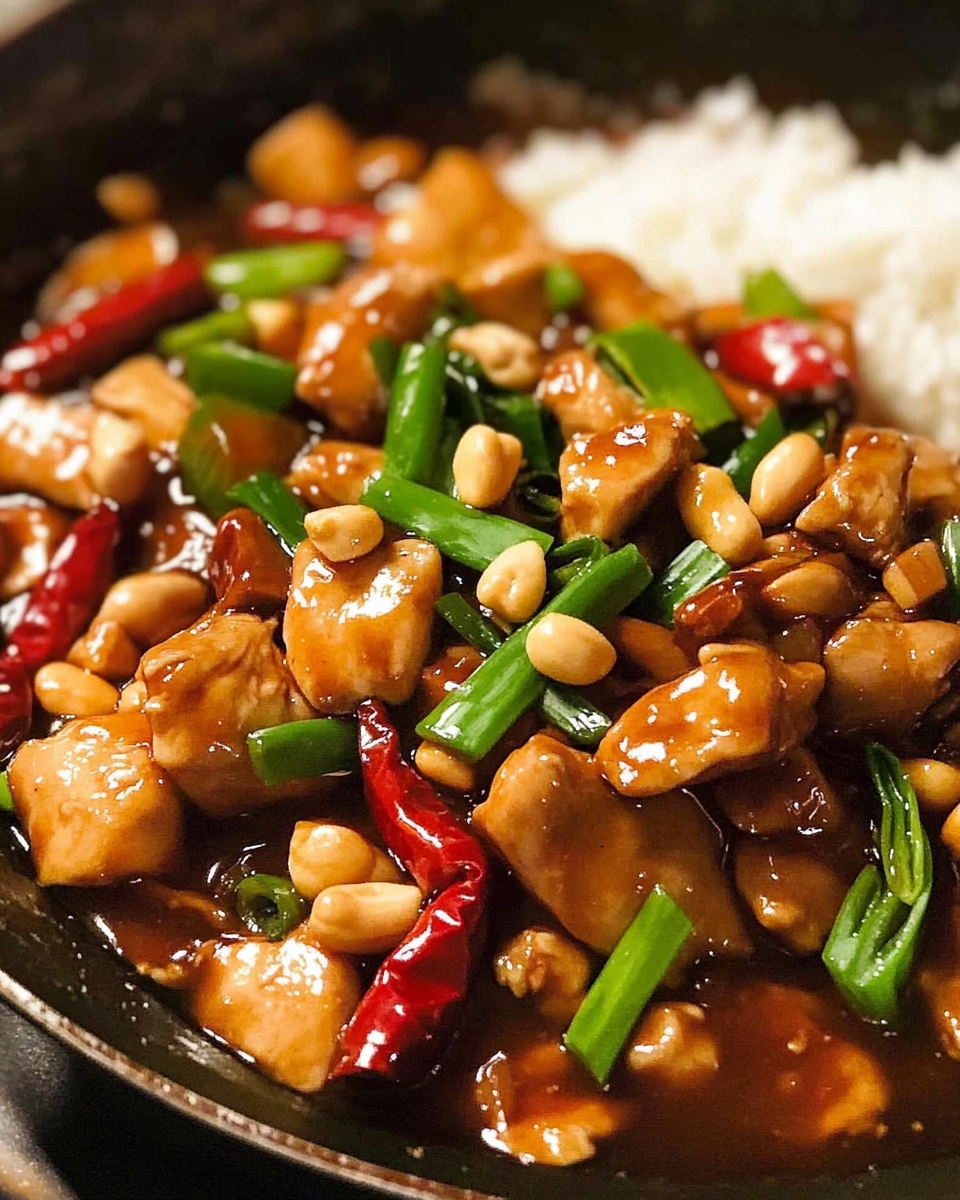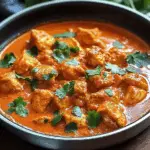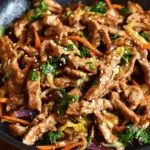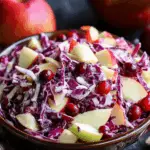Kung Pao Chicken is a vibrant dish that beautifully balances spicy, sweet, and savory flavors, all enhanced by the satisfying crunch of roasted peanuts. The deep reds of the dried chilies and the glossy sauce coating tender chicken pieces make for an inviting and colorful plate. This dish’s lively appearance pairs perfectly with steamed white rice, creating a meal that’s as visually appealing as it is delicious.
This classic Szechuan stir-fry is quick to prepare, making it ideal for busy weeknights yet impressive enough for guests. The bold flavors and textures create a comforting, satisfying experience that brings authentic Chinese home cooking straight to your table. Whether you like it mild or fiery, Kung Pao Chicken is a timeless favorite that can be tailored to suit your palate.
Full recipe:
Ingredients:
-
500g (1 lb) boneless, skinless chicken thighs, cut into bite-sized pieces
-
2 tablespoons soy sauce
-
1 tablespoon Shaoxing wine (or dry sherry)
-
1 teaspoon cornstarch
-
3 tablespoons vegetable oil
-
8-10 dried red chilies, halved and seeds removed (adjust to taste)
-
3 cloves garlic, minced
-
1 tablespoon fresh ginger, minced
-
1/2 cup roasted peanuts
-
4 green onions, sliced (white and green parts separated)
For the sauce:
-
2 tablespoons soy sauce
-
1 tablespoon dark soy sauce
-
1 tablespoon Chinese black vinegar (or balsamic vinegar)
-
1 tablespoon hoisin sauce
-
1 tablespoon sugar
-
1 teaspoon cornstarch
-
1/4 cup water
Directions:
-
In a bowl, combine chicken pieces with soy sauce, Shaoxing wine, and cornstarch. Mix well and marinate for 15 minutes.
-
In a separate bowl, whisk together all sauce ingredients until smooth. Set aside.
-
Heat 2 tablespoons of vegetable oil in a wok or large skillet over medium-high heat. Add dried chilies and stir-fry until fragrant, about 30 seconds, taking care not to burn them.
-
Add the marinated chicken and stir-fry until cooked through and lightly browned, about 5-6 minutes. Remove chicken and chilies from the wok and set aside.
-
Add the remaining 1 tablespoon of oil to the wok. Stir-fry garlic, ginger, and the white parts of green onions until aromatic, about 30 seconds.
-
Return chicken and chilies to the wok. Pour in the sauce and stir well. Cook until the sauce thickens and coats the chicken evenly, about 2 minutes.
-
Stir in roasted peanuts and the green parts of green onions. Toss quickly and remove from heat. Serve immediately with steamed rice.
Prep Time: 15 minutes | Cooking Time: 15 minutes | Total Time: 30 minutes
Kcal: Approximately 450 kcal per serving | Servings: 4 servings
The Cultural Significance of Kung Pao Chicken
Kung Pao Chicken is more than just a popular takeout choice worldwide; it holds a special place in Chinese culinary culture. It is a classic example of Sichuan cooking, which is renowned for its bold flavors, particularly the “mala” sensation — a tingling, numbing heat created by Sichuan peppercorns combined with the spicy heat of chili peppers. While Western versions often adjust the spice level for a broader audience, authentic Kung Pao Chicken remains a fiery delight.
This dish represents the ingenuity of Chinese stir-fry techniques that have been refined over centuries. Stir-frying itself is a cooking method that allows ingredients to be cooked quickly at high heat, preserving their texture, color, and nutrients. It also showcases how balance and harmony are valued in Chinese cuisine, as the contrasting flavors and textures are carefully combined to create a dish that is greater than the sum of its parts.
Flavor Profile and Key Ingredients
Kung Pao Chicken is renowned for its harmonious blend of flavors. The salty depth from soy sauce contrasts beautifully with the sweetness from sugar and the tanginess of black vinegar. The dried red chilies provide heat and a smoky aroma, while the roasted peanuts contribute a rich, nutty crunch that enhances every bite.
One of the reasons this dish is so beloved is its complexity despite relatively simple ingredients. The marinade tenderizes the chicken and infuses it with umami. The sauce, made from a mix of soy sauces, vinegar, sugar, and hoisin, creates a glossy coating that clings to each piece of chicken. Fresh ginger and garlic add a fragrant warmth, while scallions bring a mild sharpness and freshness.
The dried chilies can be adjusted according to personal taste. For those new to Sichuan cuisine, it’s common to reduce the number of chilies or remove seeds to tone down the heat. For spice lovers, the chilies provide that characteristic punch that defines the dish.
Health Considerations
While Kung Pao Chicken is incredibly tasty, it’s important to consider its nutritional aspects. This dish is rich in protein from the chicken and offers healthy fats from peanuts. It is also typically cooked quickly in oil, preserving nutrients better than longer cooking methods like boiling or stewing.
However, it can be high in sodium due to soy sauce and other seasonings, so individuals watching their salt intake should consume it in moderation or modify the recipe by using low-sodium soy sauce alternatives. Additionally, the oil content can be managed by using healthier oils or adjusting the amount used in cooking.
Incorporating plenty of vegetables into Kung Pao Chicken, such as bell peppers, zucchini, or broccoli, can increase its fiber and vitamin content, making the meal more balanced and nutritious.
Variations and Adaptations
One of the great things about Kung Pao Chicken is its versatility. While the classic recipe uses chicken thighs, you can also use chicken breast for a leaner option. For those who prefer plant-based meals, tofu or tempeh can be substituted while maintaining the core flavors with the same sauce and seasonings.
Vegetables can be added or swapped depending on seasonality or preference. Bell peppers, snow peas, carrots, or water chestnuts are popular additions that provide extra crunch and nutrition. Some versions incorporate mushrooms for added umami.
Internationally, this dish has inspired many adaptations. In American Chinese cuisine, it is often sweeter and less spicy than its traditional counterpart. Some recipes add additional sweeteners or omit the dried chilies for a milder flavor. In other parts of the world, chefs might experiment with different nuts like cashews instead of peanuts or add extra spices.
Cooking Techniques and Tips
Mastering Kung Pao Chicken requires attention to technique as well as ingredients. Stir-frying over high heat is essential to achieve the perfect texture — tender yet juicy chicken with a slightly charred, smoky flavor from the chilies. Prepping all ingredients before cooking (mise en place) is crucial since the stir-fry process is very fast.
Marinating the chicken with soy sauce, Shaoxing wine, and cornstarch helps tenderize the meat and creates a silky texture when cooked. The cornstarch also aids in thickening the sauce, which gives the dish its signature glossy finish.
It’s important to cook the dried chilies briefly to release their flavor but avoid burning them, which would result in bitterness. Adding garlic, ginger, and scallion whites right after chilies ensures the aromatic foundation of the dish. Finally, tossing in roasted peanuts at the end preserves their crunch and nutty aroma.
Serving Suggestions
Kung Pao Chicken is traditionally served with steamed jasmine or white rice, which balances the intense flavors and heat. The rice acts as a neutral base that absorbs the savory sauce, making each bite satisfying.
For a complete meal, it can be paired with simple vegetable dishes such as steamed bok choy, stir-fried greens, or a light cucumber salad. Soup dishes like hot and sour soup or egg drop soup also complement the spicy, savory profile of Kung Pao Chicken well.
In some regions, it’s enjoyed alongside noodles, especially when you want a more substantial carbohydrate base. Leftovers can be reheated and remain delicious, making it great for meal prep.
Why Kung Pao Chicken Is a Favorite Worldwide
There are many reasons Kung Pao Chicken is beloved far beyond China’s borders. Its bold and balanced flavor profile appeals to a wide range of palates. The dish manages to be fiery without overwhelming, sweet without being cloying, and salty with a hint of tang. This complexity keeps the taste buds intrigued.
Its quick preparation time also makes it perfect for busy lifestyles, offering restaurant-quality flavor at home with minimal effort. The adaptability of the recipe allows it to fit various dietary needs and ingredient availability, making it accessible globally.
Furthermore, the textural contrast—tender chicken, crunchy peanuts, and crisp aromatics—provides a satisfying eating experience that elevates it beyond typical stir-fries. It’s a dish that feels special yet approachable, making it a go-to comfort food for many.
Conclusion
Kung Pao Chicken stands as a timeless classic in Chinese cuisine, renowned for its vibrant flavors, satisfying textures, and cultural heritage. It offers a perfect balance of spicy, sweet, tangy, and savory notes, all enveloped in a glossy, flavorful sauce. Whether enjoyed as a quick weeknight dinner or a dish to impress guests, its bold taste and simple preparation make it a favorite around the world.
From its roots in Sichuan province to international kitchens, Kung Pao Chicken continues to inspire cooks to experiment and adapt while maintaining the essence of the original. Its ability to be tailored to individual preferences—whether dialing up the heat, adding vegetables, or choosing alternative proteins—ensures it remains relevant and loved.
For anyone looking to explore authentic Chinese flavors or simply craving a delicious, hearty meal, Kung Pao Chicken is an excellent choice. Its combination of aromatic spices, tender chicken, crunchy peanuts, and a vibrant sauce will delight your palate and satisfy your hunger every time.






